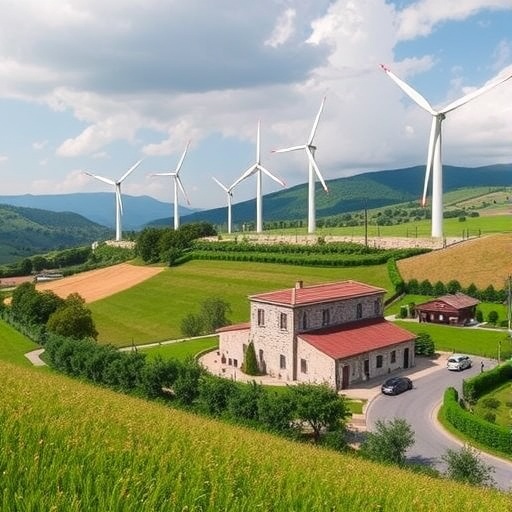In the heart of Alta Irpinia, a region steeped in agricultural tradition and archaeological significance, an urgent debate unfolds that interlaces climate ambitions with social justice. A groundbreaking study published in the acclaimed journal Renewable and Sustainable Energy casts a critical eye on the rapid industrialization of wind farms and its rippling effects on local socio-economic structures. This analysis underscores the complex reality behind green energy transitions, especially when large-scale infrastructure projects alter not only the natural landscape but also the very fabric of rural communities.
The investigation spearheaded by Dr. Antonio Sibilia and Professor Marina Calloni meticulously dissects how 403 operational wind turbines, already exceeding 600 MW in capacity, have redefined Alta Irpinia. With an additional 113 turbines licensed, the proliferation of these structures has transformed the region into what locals increasingly perceive as a resource extraction site, diluting diverse rural identities and reshaping land use. Historically an area marred by seismic activity and demographic decline, Alta Irpinia now confronts the dilemmas posed by ambitious decarbonization goals clashing with entrenched socio-cultural ecosystems.
Expanding renewable energy infrastructure is an indisputable global imperative to mitigate climate change. Yet, as this study compellingly reveals, the absence of robust participatory frameworks in energy planning compounds inequalities and threatens to marginalize the very communities that bear the brunt of these developments. Through a qualitative survey approach featuring 13 semi-structured interviews with residents, farmers, civic groups, and administrators, the research provides an intimate glimpse into societal fractures intensified by the uneven distribution of economic benefits emerging from wind farm installations.
Central to the study’s revelations is the phenomenon referred to by locals as “economic doping.” Royalties channeled predominantly to a select group of large landowners have distorted traditional agricultural markets, undermining small-scale farming operations and deepening socioeconomic divides. The conversion of croplands and pastures into industrial wind energy sites disrupts established production cycles and erodes the rural economies that have sustained Alta Irpinia for generations. In this context, the green energy transition paradoxically engenders distress rather than prosperity for many inhabitants.
The paper importantly dismantles simplistic notions that local opposition to wind farms stems merely from Not In My Back Yard (NIMBY) attitudes. Instead, it elucidates a broader contestation embedded in concerns over environmental justice, democratic inclusion, and territorial autonomy. Resistance movements are thus reinterpreted as legitimate expressions of community agency demanding meaningful participation in decisions that impact their landscapes, livelihoods, and identities. This challenges technocratic paradigms that prioritize centralized control over grassroots engagement within energy policy frameworks.
Culturally, the study situates the landscape as more than a picturesque backdrop; it is an active embodiment of memory, heritage, and social relations. The authors evoke the image of the xoanon, an ancient wooden cult figure with profound archaeological resonance for the province of Avellino, overlaid with wind turbine silhouette and iconic local flora—vineyards, wheat fields, and olive groves—to symbolize the tension between tradition and industrial modernity. Such representations emphasize how landscape transformation intertwines with narratives of belonging and historical continuity.
The consequences of imposing large-scale energy infrastructures in earthquake-vulnerable territories add a layer of complexity often overlooked in climate policy discourses. Physical vulnerability intersects with social disempowerment, raising questions about the resilience of both ecosystems and communities in managing multifaceted risks. Consequently, the push for decarbonization must reckon with place-based vulnerabilities and specificities rather than adopting uniform, top-down models.
Recognizing these dimensions, the study advocates for an alternative energy transition paradigm anchored in local knowledge systems and cultural attachments. This entails designing benefit-sharing mechanisms that equitably redistribute economic gains, thereby counterbalancing the monopolization tendencies observed in the current development model. Equally critical is fostering democratic governance structures where affected stakeholders hold genuine decision-making power, ensuring that transitions are as just as they are sustainable.
Technologically, the research does not undermine the necessity of expanding renewable capacities but calls for integrating social sciences insights into engineering projects from inception through operation. Without embedding social justice principles into energy infrastructure planning, there is a risk of perpetuating exclusionary practices that alienate rural populations and erode the social license essential for long-term sustainability. This interdisciplinary approach is vital in navigating the paradoxes inherent in green transformations.
The Alta Irpinia case study thus serves as a microcosm of global challenges faced in harmonizing urgent climate action with the preservation of rural livelihoods and intangible heritage assets. It spotlights the critical need to recalibrate national energy agendas to accommodate localized contexts, ensuring that vulnerable regions are not mere sites for carbon neutrality targets but active beneficiaries of the green economy. Such recalibration is indispensable if energy transitions are to fulfill promises of equity and resilience.
Ultimately, this research powerfully asserts that energy models are inseparable from social models. The modalities through which energy is produced shape community dynamics, identity constructions, and modes of citizenship participation. Therefore, a just energy future necessitates a holistic understanding that transcends mere technological metrics, embedding core values of redistribution, cultural respect, and environmental stewardship at its foundation.
Alta Irpinia has undeniably contributed significantly to national decarbonization objectives, yet this contribution must be acknowledged not only in megawatts but also in tangible rewards for local communities. The call to “rebalance the transition” resonates as an urgent policy imperative, beckoning governments, planners, and stakeholders worldwide to confront the nuanced socio-environmental intricacies of renewable energy expansion. Only through inclusive, context-sensitive strategies can the promise of a sustainable and equitable energy future be truly realized.
Article Title: Green vs. Green: wind farms and farming communities in Alta Irpinia (Campania Region, Italy)
News Publication Date: 15 September 2025
Web References: https://doi.org/10.55092/rse20250006
Image Credits: Field photographs by A. Sibilia, A. Fasano (Alta Irpinia, 2024-2025); Illustration by A. Sibilia (2025)
Keywords: Energy policy, Resource policy, Environmental justice, Renewable energy transition, Rural development, Social participation




